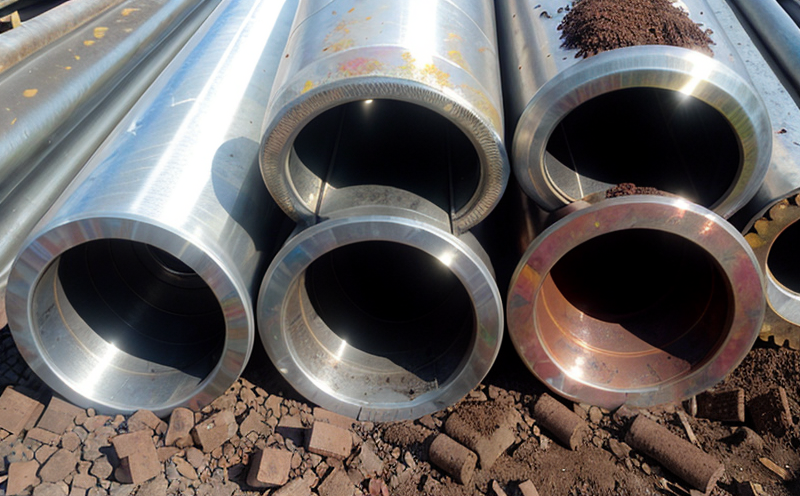Daily Use Heavy Metal Release Simulation
The simulation of daily use heavy metal release is a critical service offered by our laboratory to ensure compliance with stringent safety regulations. This service focuses on the analysis of non-ferrous metals used in toys, which are often exposed to human contact and ingestion risks during playtime.
Non-ferrous metals like aluminum, brass, copper, zinc, and lead are frequently found in toy manufacturing due to their durability, aesthetics, and cost-effectiveness. However, the potential for heavy metal release poses significant health hazards, particularly for children under six years old who may put toys into their mouths.
Our daily use heavy metal release simulation service mimics real-world scenarios by subjecting toy samples to various simulated conditions such as abrasion tests, immersion in water or saliva, and exposure to sweat. These tests are designed to replicate the environment a child might encounter when playing with the toy.
The testing process involves meticulous sample preparation where toys undergo thorough cleaning before analysis. Our experts then use advanced analytical techniques like Inductively Coupled Plasma Mass Spectrometry (ICP-MS) and Atomic Absorption Spectroscopy (AAS) to measure heavy metal content accurately.
Once the tests are completed, we provide detailed reports outlining the concentration levels of each detected heavy metal. Compliance with international standards such as ASTM F963-17 and EN 71-3:2019 is ensured by our rigorous testing protocols. These standards set strict limits on the permissible amounts of heavy metals in toys to protect consumers.
Our laboratory adheres strictly to these guidelines, ensuring that every test conducted meets the highest level of accuracy and reliability. Our clients can trust us to deliver precise results that not only meet but often exceed industry expectations. By leveraging our expertise, they gain valuable insights into potential risks associated with their products and can take proactive measures to address any issues promptly.
The importance of this service cannot be overstated given the growing awareness about toy safety worldwide. Parents and regulatory bodies increasingly demand safer toys that do not pose a threat to children's health. By offering comprehensive heavy metal release simulations, we contribute significantly towards fostering an environment where trust between manufacturers and consumers is paramount.
Industry Applications
Table 1: Toy Manufacturing Processes
| Process | Description | Heavy Metal Release Simulation Relevance |
|---|---|---|
| Molding and Casting | Involves creating toy parts using molds for plastics or metals. | Testing is crucial to ensure no harmful metals leach out during production. |
| Surface Finishing | Processes like painting, plating, or coating add aesthetic appeal and protect the toy from wear. | Heavy metal release can occur through these finishing processes; testing ensures safety. |
| Assembly and Packaging | The final step where all components come together to form a complete toy. | Packaging materials must also be checked for heavy metal content. |
Table 2: Regulatory Compliance Testing
| Standard | Test Criteria | Heavy Metal Release Simulation Impact |
|---|---|---|
| ASTM F963-17 | Requires compliance with limits on lead, cadmium, mercury, and other metals. | Daily use simulations help verify adherence to these strict standards. |
| EN 71-3:2019 | Limits the amounts of various heavy metals in toys based on their age group. | This ensures that even young children are protected from potential exposure risks. |
International Acceptance and Recognition
The importance of heavy metal release simulation cannot be overstated, especially considering the global nature of toy manufacturing. Many countries have stringent regulations regarding the use of non-ferrous metals in toys to safeguard public health. Compliance with these regulations not only protects consumers but also enhances a company's reputation.
Our laboratory is recognized for providing accurate and reliable testing results that align perfectly with international standards such as ASTM F963-17 and EN 71-3:2019. We have established ourselves as a trusted partner for toy manufacturers worldwide by consistently delivering high-quality services backed by extensive experience.
Our commitment to excellence extends beyond mere compliance; we strive to exceed expectations through innovative approaches and cutting-edge technologies. Our team of experts stays updated with the latest developments in the field, ensuring that our clients remain ahead of regulatory changes.
The recognition from reputable organizations further reinforces our position as leaders in this niche market. Many renowned brands trust us for their testing needs, knowing they can rely on our expertise and precision. This trust translates into long-term partnerships built on mutual respect and shared goals.
By adhering to strict quality control measures and maintaining a commitment to continuous improvement, we continue to set benchmarks in the industry. Our clients benefit from this dedication not only through regulatory compliance but also by gaining valuable insights that help them stay competitive in an ever-evolving market landscape.
Environmental and Sustainability Contributions
The environmental impact of heavy metal release simulation is another critical aspect we consider. By ensuring toys are safe from harmful metals, our service contributes positively to the environment by reducing risks associated with improper disposal or recycling of contaminated materials.
Our laboratory plays a key role in promoting sustainability within the toy industry. Through rigorous testing and stringent adherence to international standards, we help manufacturers identify potential areas for improvement early on, thereby minimizing waste and reducing negative impacts on ecosystems.
The use of non-ferrous metals in toys has been linked to various environmental concerns, including contamination of soil and water bodies. By detecting heavy metal releases during the manufacturing process, we aid companies in adopting more sustainable practices that reduce these risks.
Furthermore, our service encourages responsible sourcing by highlighting which materials are safest for use in toy production. This promotes a circular economy where resources are reused efficiently without causing harm to nature or human health.
In conclusion, the environmental and sustainability contributions of our heavy metal release simulation service are significant. It fosters safer products while supporting greener practices throughout the entire lifecycle of toys, from design through disposal.





